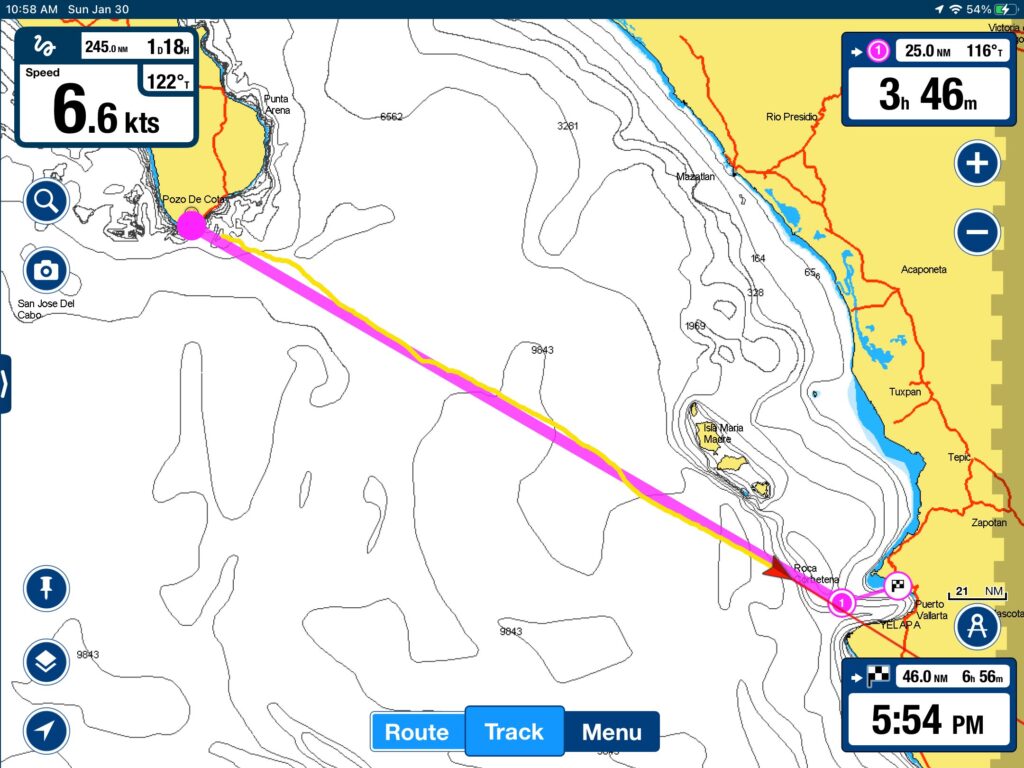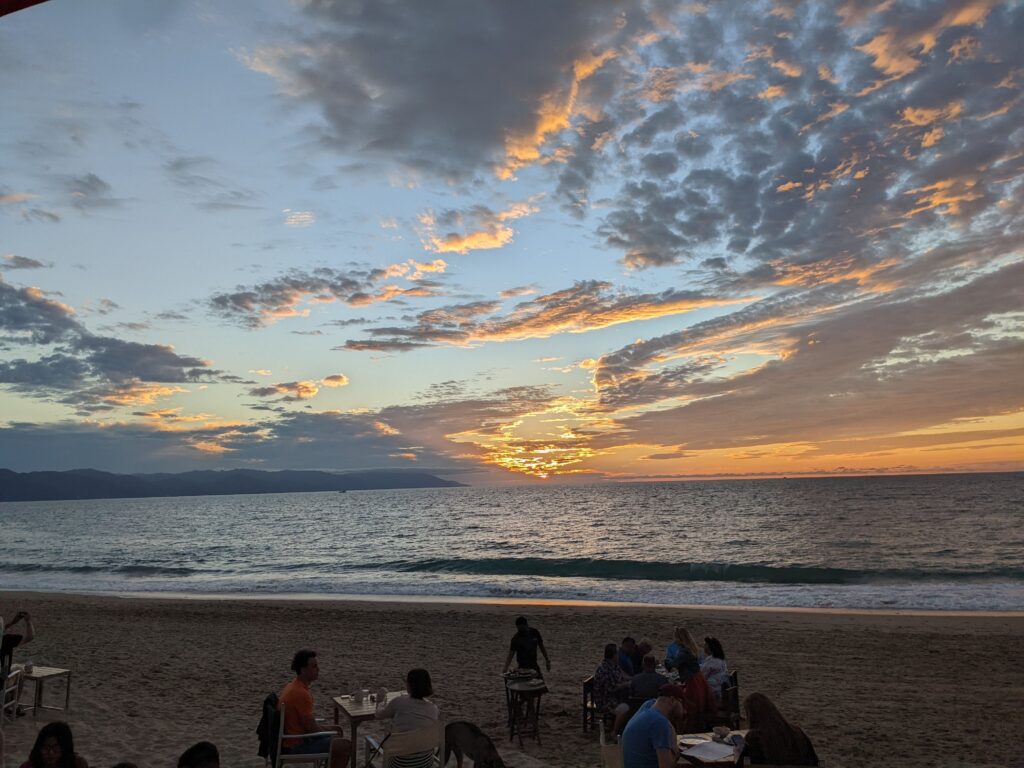Leaving Cabo
There are nerves with every big departure. This was my first one solo for years, and it started with so much euphoria that I was dancing in the cockpit to Britney Spears’ “Toxic” (Peter Rauhofer remix from “B in the Mix – The Remixes). It was a beautiful escape from my least favorite Mexican city, with enough wind to sail smoothly, and since the wind was coming from the land and pushing me out to sea, there was very little swell.
Insta: sv.chemistry
Why is Cabo my least favorite Mexican city? Well, to be fair I have to say it’s possible that I’ve missed any interesting or special parts of the city if they exist, because I rarely left the area where the city must surely be at its worst—the marina district and the beach/bay. However my assumption has always been that the only thing outside of the city are huge time-share resorts and golf courses, but again, that’s just an assumption.
While at anchor you’re buzzed by pangas and gangs of jet skis during the day, and at night the booze cruises ghost past on massive catamarans blaring music while decks are full of young Americans drinking all they can while the bar is open. At night the anchorage is rolly as the wind comes from the west while Pacific Ocean swells wrap around the point and hit you from the south.
In the marina you’re surrounded by restaurants and hotels (like most Mexican marinas), and you’re continuously harassed on the malecon to go fishing or to sit down and have something to eat. I have no problem with people trying to earn a living by getting tourists to hire them for charter or to sit at their tables, but the bombardment makes the city less attractive to me. You’re just constantly on guard ready to say “No, gracias” to most everyone. Buffy helps in this regard, as just her being there indicates that I either live there or I’m a long-term resident of some sort (because who would bring their medium-sized dog along on a two-week Cabo vacation?), so I think I have to decline fewer offers than most.
Lumpy Shiftiness & Nighttime Howling
After making some progress away from the cape, the wind was shifty as I was in the wind shadow of the cape but also caught between a Pacific Ocean westerly and the Sea of Cortez northerly, and the swells of each were hitting me from both sides. Although I had 10 shifty knots of wind, these dueling swell patterns made me start up the engine and try to get to clean air and swells as soon as possible. When I made enough easting to let the SoC northerly take control, it took control with a vengeance, and throughout the first night I had 20 – 30 knots on my port beam and I was absolutely flying at 6.5 – 7.5 knots through the water under full main and reefed genoa. Eventually the full main became a hazard and I reefed, and was super-happy to discover that with the amazing Harken Battcar system I had no problems whatsoever reefing while going downwind. For non-sailors reading this, please note: this is a big deal; it is terribly uncomfortable to stop the progress of the boat to point directly into the wind so you can partially drop the main, and during that time you’re pointed into 20-30 knots of wind it feels like the world could end at any moment. It’s scary. The Harken Battcar system means the sail slides so easily cup and down the track at all angles of sail, that all I need to do to reef the main is ease the main halyard a bit, go up to the mast to hook the grommet into the hooks where the mast meets the boom, then tighten the reefing line, then raise the main halyard again until snug to secure the tack grommet onto the hook. Some solo sailors will cringe at even having to go forward to the mast to put the grommet into the hook, but I’m constantly wearing a harness and tethered into jacklines and feel pretty secure.
The heroes of this crossing were my auto-pilots. That first night, my Hydrovane steered me on a beam reach through the most difficult part of the crossing, while allowing me to stay focused on other things like keeping the sails properly reefed and balanced and keeping Buffy content. When we came out the other side and the wind died closer to the Marias islands, the engine and wheel-mounted autopilot became hugely important, and that autopilot performed admirably as well. We motor-sailed the final 60 or so miles through fairly flat and windless waters after the Marias islands, from dawn of the third day all the way to La Cruz de Huanacaxtle, dropped anchor slightly after sunset, and I slept like a rock.
Paperwork Hassles
On Monday I started with a bit of work, and eventually headed into a slip at Marina La Cruz, where I discovered that everything was not in order, as some miscommunication between myself and the Port Captain of Cabo San Lucas (el capitania) meant I didn’t have the proper paperwork to check into the next port. This meant I had to go to a full port-of-entry and possibly another trip through customs “aduana”, meaning I had to go to Puerto Vallarta. With some help from a local worker at a yacht maintenance company who knocked on my boat to sell services and eventually came with me to talk to the capitania, I was able to get all the correct papers so I’m ready to head back to La Cruz as soon as some work is done—that work being the replacement of lazy jack lines that broke on the second day of the crossing.
Puerto Vallarta is infinitely better than Cabo for many reasons, but living in a marina is still not my ideal—mostly because it’s so hot during mid-day because there’s less of a breeze blowing through the anchorage. But the people are nicer, the general feeling more chill, and the streets while still bumpy like Cabo are bumpy now because of romantic cobblestones.


Next destination is La Cruz de Huanacaxtle on the north side of Banderas Bay, where I’ll probably spend the rest of February. I’d like to get to Melaque / San Patricio for Dia de San Patricio (March 17), but I’ve started a new project at work that requires more data downloads and client interaction, so I’m a bit concerned about that keeping me in marinas for the near future for better Internet. We’ll see; I used a ridiculous amount of 4g Internet my first five days in Cabo, but I’m not sure how much of that was Windows Update or Google Play Store app updates, or if I’m more careful now if I’ll actually be able to work effectively with 4g and not have to rely on marina WiFi. We’ll see.
This entry was posted in Sailing Log